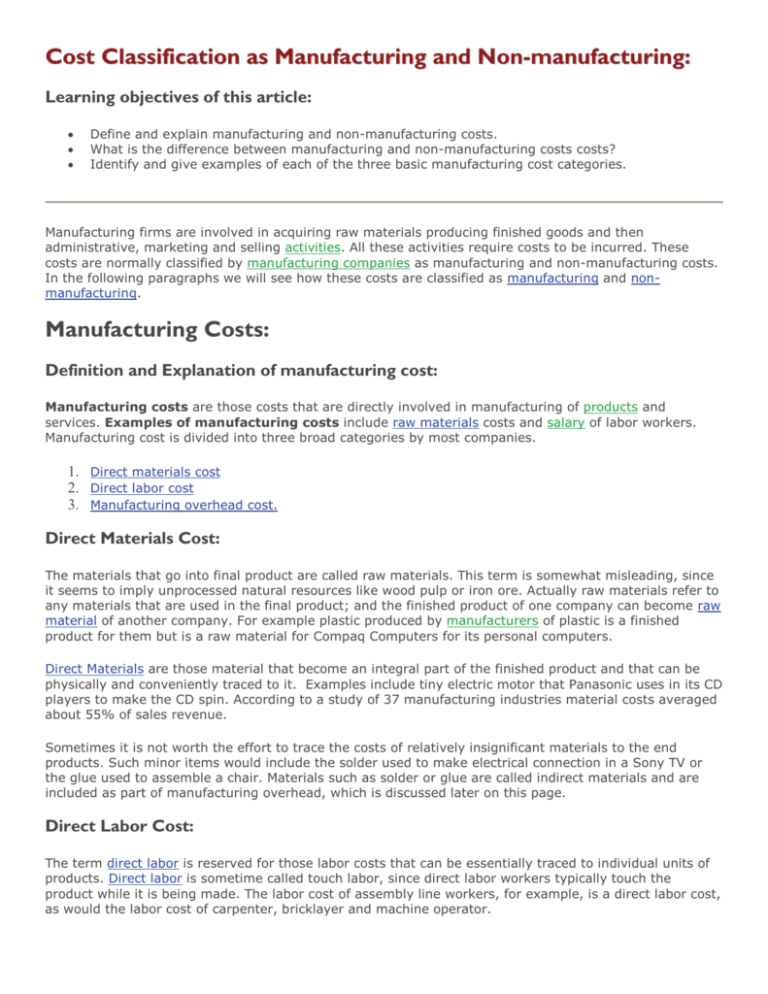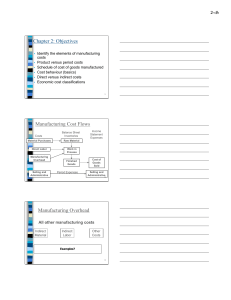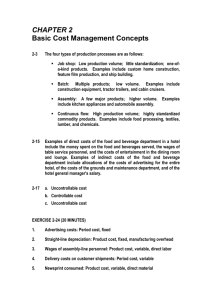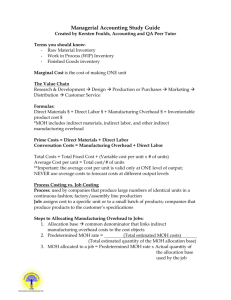Cost Classification as Manufacturing and Non
advertisement

Cost Classification as Manufacturing and Non-manufacturing: Learning objectives of this article: • • • Define and explain manufacturing and non-manufacturing costs. What is the difference between manufacturing and non-manufacturing costs costs? Identify and give examples of each of the three basic manufacturing cost categories. Manufacturing firms are involved in acquiring raw materials producing finished goods and then administrative, marketing and selling activities. All these activities require costs to be incurred. These costs are normally classified by manufacturing companies as manufacturing and non-manufacturing costs. In the following paragraphs we will see how these costs are classified as manufacturing and nonmanufacturing. Manufacturing Costs: Definition and Explanation of manufacturing cost: Manufacturing costs are those costs that are directly involved in manufacturing of products and services. Examples of manufacturing costs include raw materials costs and salary of labor workers. Manufacturing cost is divided into three broad categories by most companies. 1. Direct materials cost 2. Direct labor cost 3. Manufacturing overhead cost. Direct Materials Cost: The materials that go into final product are called raw materials. This term is somewhat misleading, since it seems to imply unprocessed natural resources like wood pulp or iron ore. Actually raw materials refer to any materials that are used in the final product; and the finished product of one company can become raw material of another company. For example plastic produced by manufacturers of plastic is a finished product for them but is a raw material for Compaq Computers for its personal computers. Direct Materials are those material that become an integral part of the finished product and that can be physically and conveniently traced to it. Examples include tiny electric motor that Panasonic uses in its CD players to make the CD spin. According to a study of 37 manufacturing industries material costs averaged about 55% of sales revenue. Sometimes it is not worth the effort to trace the costs of relatively insignificant materials to the end products. Such minor items would include the solder used to make electrical connection in a Sony TV or the glue used to assemble a chair. Materials such as solder or glue are called indirect materials and are included as part of manufacturing overhead, which is discussed later on this page. Direct Labor Cost: The term direct labor is reserved for those labor costs that can be essentially traced to individual units of products. Direct labor is sometime called touch labor, since direct labor workers typically touch the product while it is being made. The labor cost of assembly line workers, for example, is a direct labor cost, as would the labor cost of carpenter, bricklayer and machine operator. Labor costs that cannot be physically traced to the creation of products, or that can be traced only at a great cost and inconvenience, are termed indirect labor and treated as part of manufacturing overhead, along with indirect materials. Indirect labor includes the labor costs of janitors, supervisors, materials handlers, and night security guards. Although the efforts of these workers are essential to production, it would be either impractical or impossible to accurately trace their costs to specific units of product. Hence, such labor costs are treated as indirect labor. In some industries, major shifts are taking place in the structure of labor costs. Sophisticated automated equipment, run and maintained by skilled workers, is increasingly replacing direct labor. In a few companies, direct labor has become such a minor element of cost that it has disappeared altogether as a separate cost category. However the vast majority of manufacturing and service companies throughout the world continue to recognize direct labor as a separate cost category. According to a study of 37 manufacturing industries, direct labor averaged only about 10% of sales revenue. Direct Materials cost combined with direct labor cost is called prime cost. In equation form: Prime Cost = Direct Materials Cost + Direct Labor Cost For example total direct materials cost incurred by the company is $4,500 and direct labor cost is $3,000 then prime cost is $7,500 ($4,500 + $3,000). Manufacturing Overhead Cost: Manufacturing overhead, the third element of manufacturing cost, includes all costs of manufacturing except direct material and direct labor. Examples of manufacturing overhead include items such as indirect material, indirect labor, maintenance and repairs on production equipment and heat and light, property taxes, depreciation, and insurance on manufacturing facilities. Indirect materials are minor items such as solder and glue in manufacturing industries. These are not included in direct materials costs. Indirect labor is a labor cost that cannot be trace to the creation of products or that can be traced only at great cost and inconvenience. Indirect labor includes the labor cost of janitors, supervisors, materials handlers and night security guards. Costs incurred for heat and light, property taxes, insurance, depreciation and so forth associated with selling and administrative functions are not included in manufacturing overhead. Studies have found that manufacturing overhead averages about 16% of sales revenue. Manufacturing overhead is known by various names, such as indirect manufacturing cost, factory overhead, and factory burden. All of these terms are synonymous with manufacturing overhead. Manufacturing overhead cost combined with direct labor is called conversion cost. In equation form: Conversion Cost = Direct Labor Cost + Manufacturing Overhead Cost For example if total direct labor cost is $3,000 and total manufacturing overhead cost is $2,000 then conversion cost is $5,000 ($3,000 + $2,000). Non-manufacturing Costs: Definition and explanation of non-manufacturing cost: Non-manufacturing costs are those costs that are not incurred to manufacture a product. Examples of such costs are salary of sales person and advertising expenses. Generally non-manufacturing costs are further classified into two categories. 1. Marketing and Selling Costs 2. Administrative Costs Marketing or Selling Costs: Marketing or selling costs include all costs necessary to secure customer orders and get the finished product into the hands of the customers. These costs are often called order getting or order filling costs. Examples of marketing or selling costs include advertising costs, shipping costs, sales commission and sales salary. Administrative Costs: Administrative costs include all executive, organizational, and clerical costs associated with general management of an organization rather than with manufacturing, marketing, or selling. Examples of administrative costs include executive compensation, general accounting, secretarial, public relations, and similar costs involved in the overall, general administration of the organization as a whole. Summary of manufacturing and non-manufacturing costs Manufacturing Costs Direct Materials: Materials that can be physically and conveniently traced to a product, such as wood in a table. Direct Labor: Labor costs that can be physically and conveniently traced to a product such as assembly line workers in a plant. Direct labor is also called touch labor cost. Conversion Cost (Direct Labor + Overhead Cost) Manufacturing Overhead: All costs of manufacturing a product other than direct materials and direct labor, such as indirect materials, indirect labor, factory utilities, and depreciation of factory equipment. Non-manufacturing Costs Marketing or selling costs: All costs necessary to secure customer orders and get the finished product or service into the hands of the customer, such as sales commission, advertising, and depreciation of delivery equipment and finished goods warehouse. Administrative Costs: All costs associated with the general management of the company as a whole, such as executive compensation, executive travel costs, secretarial salaries, and depreciation of office building and equipment. Prime Cost (Direct Materials + Direct Labor)







